Shelby Township, MI
Home MenuGovernment » Departments » Parks and Recreation » Burgess-Shadbush Nature Center
Nature News & Programs
Nature News
Download the latest news here to keep up with what's happening at the nature center.
Nature Center Trail Map
Download the nature center map featuring both nature trails behind the center.
Learn with Nature
Our Nature Center Program Series is geared towards groups of all ages including (but not limited to):
- Field Trips
- Boy & Girl Scout Groups
- Home School Groups and Cooperatives
- Social/ Academic Clubs
- Study Groups
Our programs take place at the Burgess-Shadbush Nature Center and are based on an environmental topic of your choice with both an indoor and outdoor portion.
Using our donated collection of mounted specimens and scientific equipment, we lead the children in discussion and exploration of the chosen topic inside our nature center classroom.
The outdoor portion of the program varies based on the topic but usually includes a walk along one of our trails where we further discuss and encourage the kids to come up with questions about the program.
These programs usually run 1.5 - 2 hours in length, including the outdoor portion.
For information on any of our programs, please call us at 586-323-2478.
Plan a field trip
The Burgess-Shadbush Nature Center welcomes individual scouting groups, school groups, and organizations to schedule programs with us. All ages are welcome, and we are excited to plan an event suited to your wishes. We invite you to contact the Nature Center for a listing of topics that we offer or to tailor a program to badge, classroom, or other learning requirements. At least one adult leader is required for every 6 youth attending the program. Please contact the Nature Center for details and availability.Nature Center Teaching Gardens
Enjoy our award-winning Teaching Gardens when you visit the center. The Pollinator Garden is a great way see just how important pollinating animals and insects are to plant life. The Herb Garden identifies the delicious herbs usually found in our kitchen. The Deer-Resistant Garden is a fenced area to keep out deer and demonstrate the impact those animals have on the ecosystem. These beautiful and educational gardens are maintained by a crew of volunteers coordinated by dedicated Shelby Township resident, Dianne Granthen. Break out your camera to capture the beauty or just take a stroll and let nature find you - these gardens are a must-see.
Nature Facts
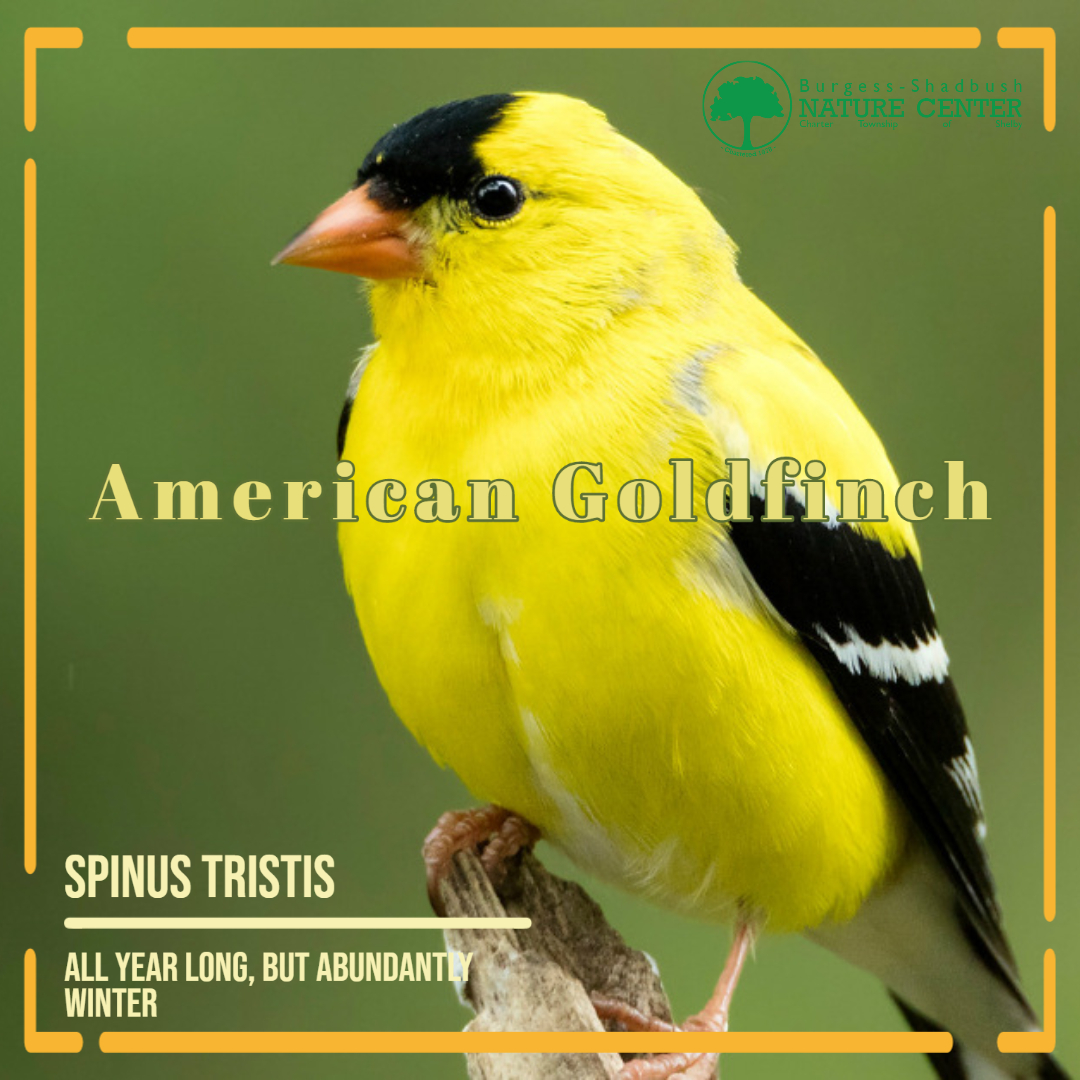 American Goldfinch
American Goldfinch
The American Goldfinch (Spinus tristis) is a small finch with conical bill and small head, long wings and short, notched tail.
Their natural habitats are weedy fields and floodplains where thistles and asters are common. You can find them at feeders all year round but you'll see them abundantly in winter.
Breeding males (pictured) are bright yellow with black forehead and black wings with white markings.
Blue Jay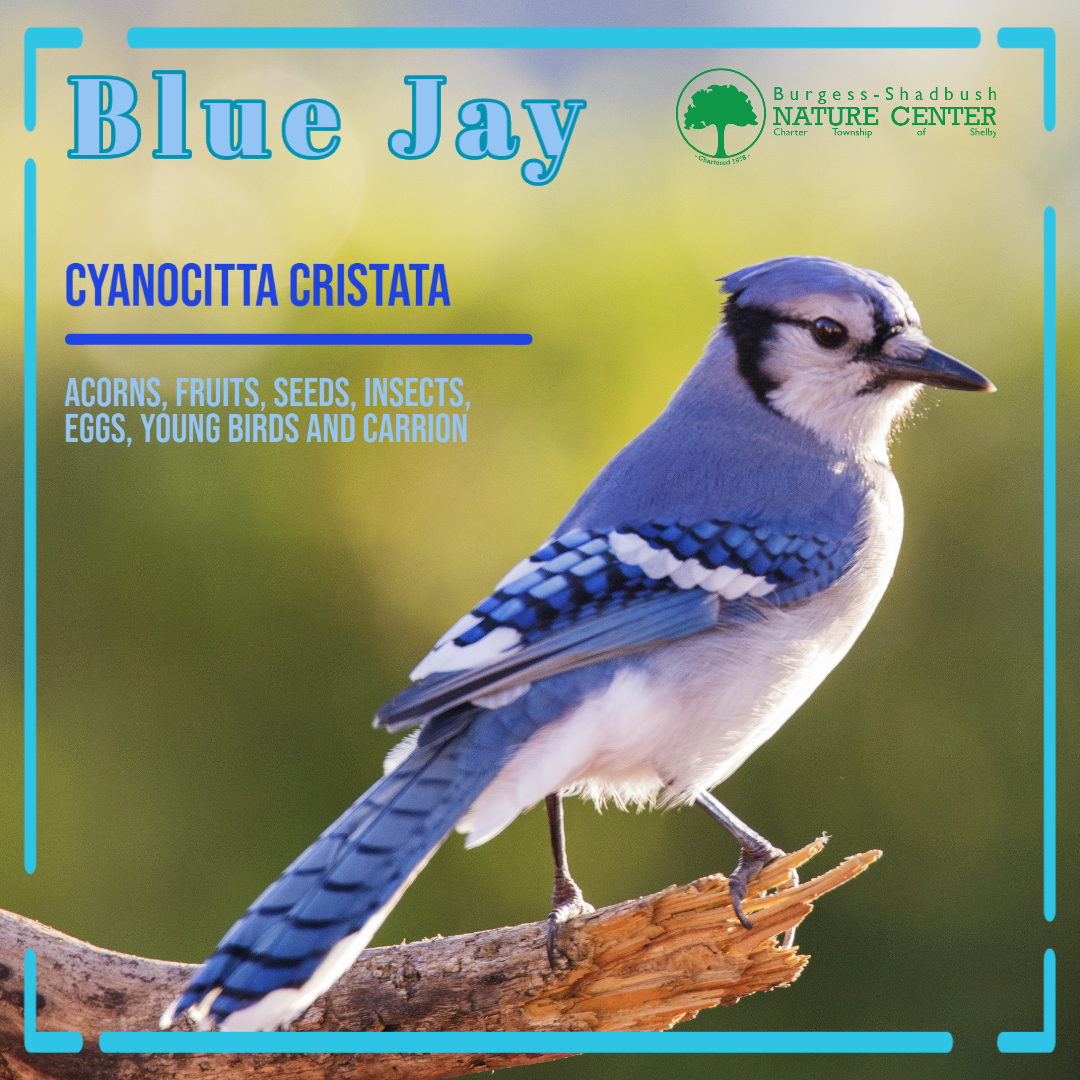
Blue jays (Cyanocitta cristata) are relatively large songbirds (about the size of a robin) with blue upperparts and whitish underparts. A blue crest on the head can be raised or lowered depending on the bird’s mood.
The voice varies from murmurs to screams to clear, chime-like whistles.
Bald blue jays (blue jays without feathers on their heads) are usually reported in summer and fall when they are molting. New feathers grow soon after.
The assertiveness of blue jays extends to their relationship with potential predators. Their screaming and mobbing behaviors serve to protect many bird species against hawks, owls, cats and other predators.
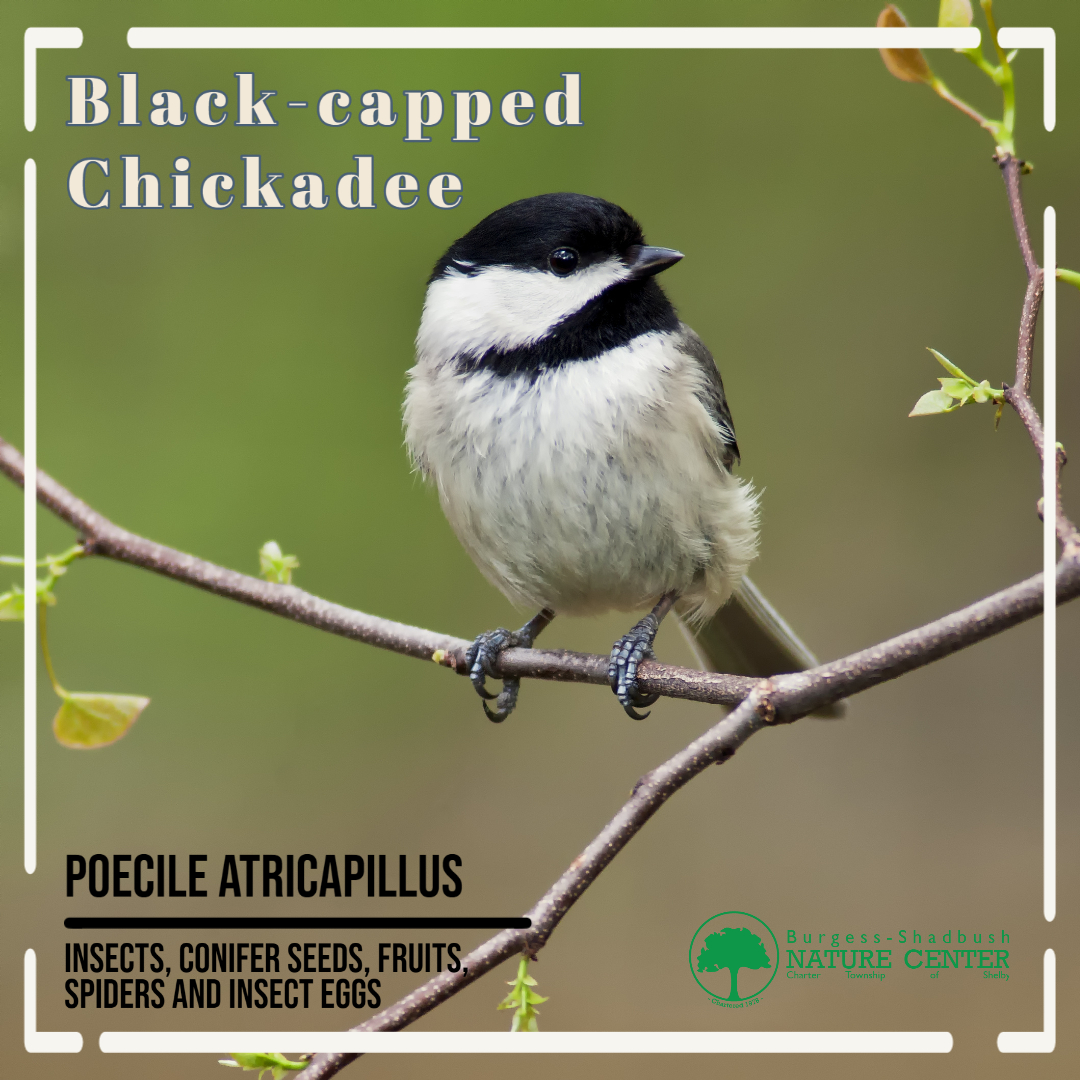 Chickadee
Chickadee
Black-capped Chickadee (Poecile atricapillus) have black throats and dark heads. There is little difference between adults, juveniles, males or females. Their name "chickadee" imitates the sounds of their distinctive vocalizations.
Black-capped Chickadee nests are built in tree cavities, often in deciduous snags, and lined with moss, hair, plant down, feathers, and insect cocoons. If an abandoned hollow (or nest box) is not used, both parents excavate and line the cavity within 10-14 days.
The diet of the Black-capped Chickadee consists of insects, conifer seeds, fruits, spiders and insect eggs gleaned from shrubs and tree bark. While feeding, these active and agile birds often hang upside down from twigs. Social and unwary, these chickadees are easily attracted to bird feeders.
Eastern Kingbird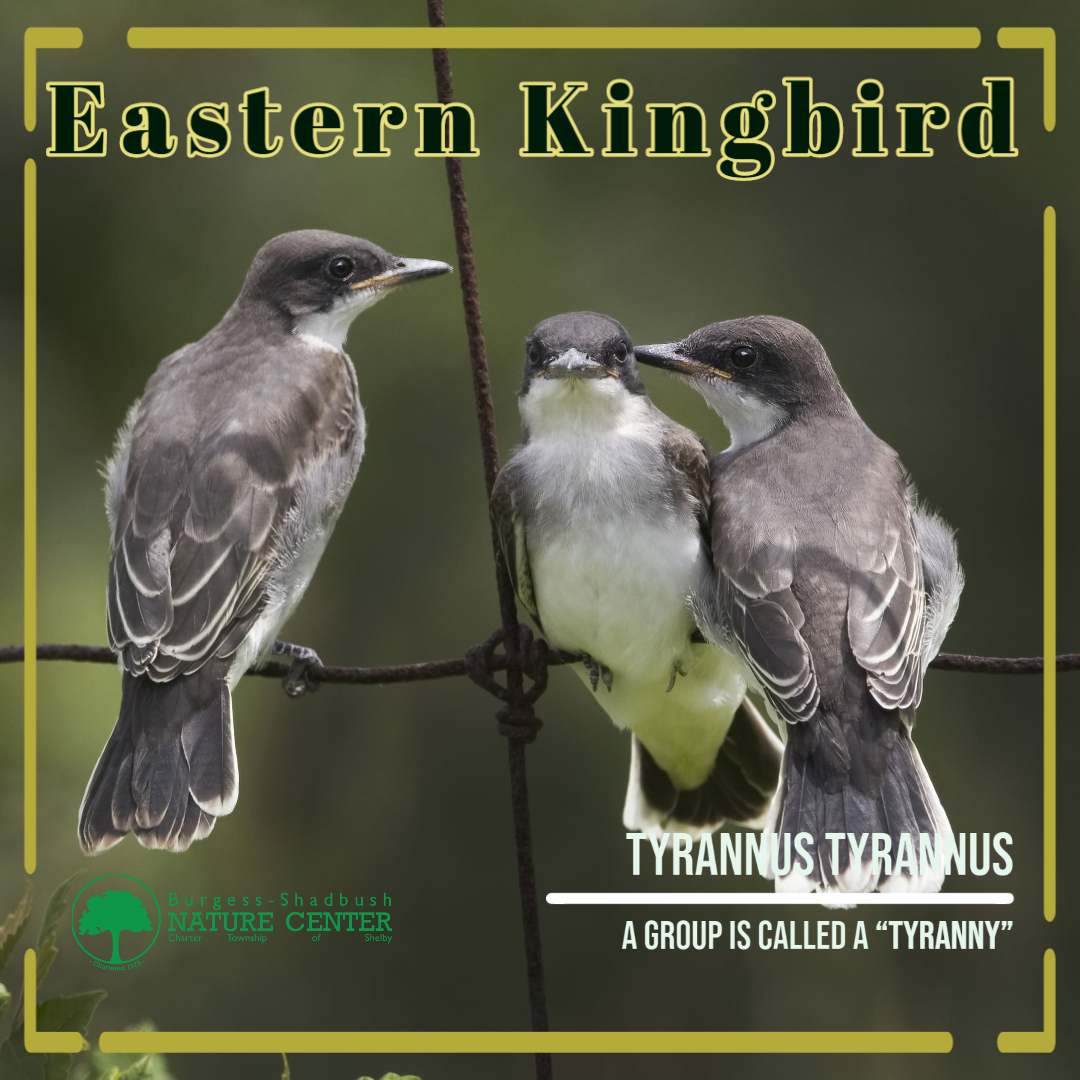
Have you ever seen a tyranny of kingbirds?
The eastern kingbird is a robin-sized bird commonly described as "wearing a suit" because of the white belly and neck and dark "jacket" as their wings and head. A group of kingbirds is referred to as a "court", "coronation" or a "tyranny," the last probably due to its spunk attitude.
Kingbirds can usually be found perched on field fences and wire before diving to swoop up insects like wasps, beetles, winged ants and grasshoppers. They also have a habit of harassing larger birds like hawks, crows and blue jays in order to defend their territory and nests.
They're called kingbirds because they have a yellow, red or orange crown on feathers on their head, though it's usually concealed (like in the picture). However, when threatened, the kingbird will raise the bright crown before attacking.
While these birds are amusing and beautiful to watch, it's best to keep your distance unless you want to test their aggression.
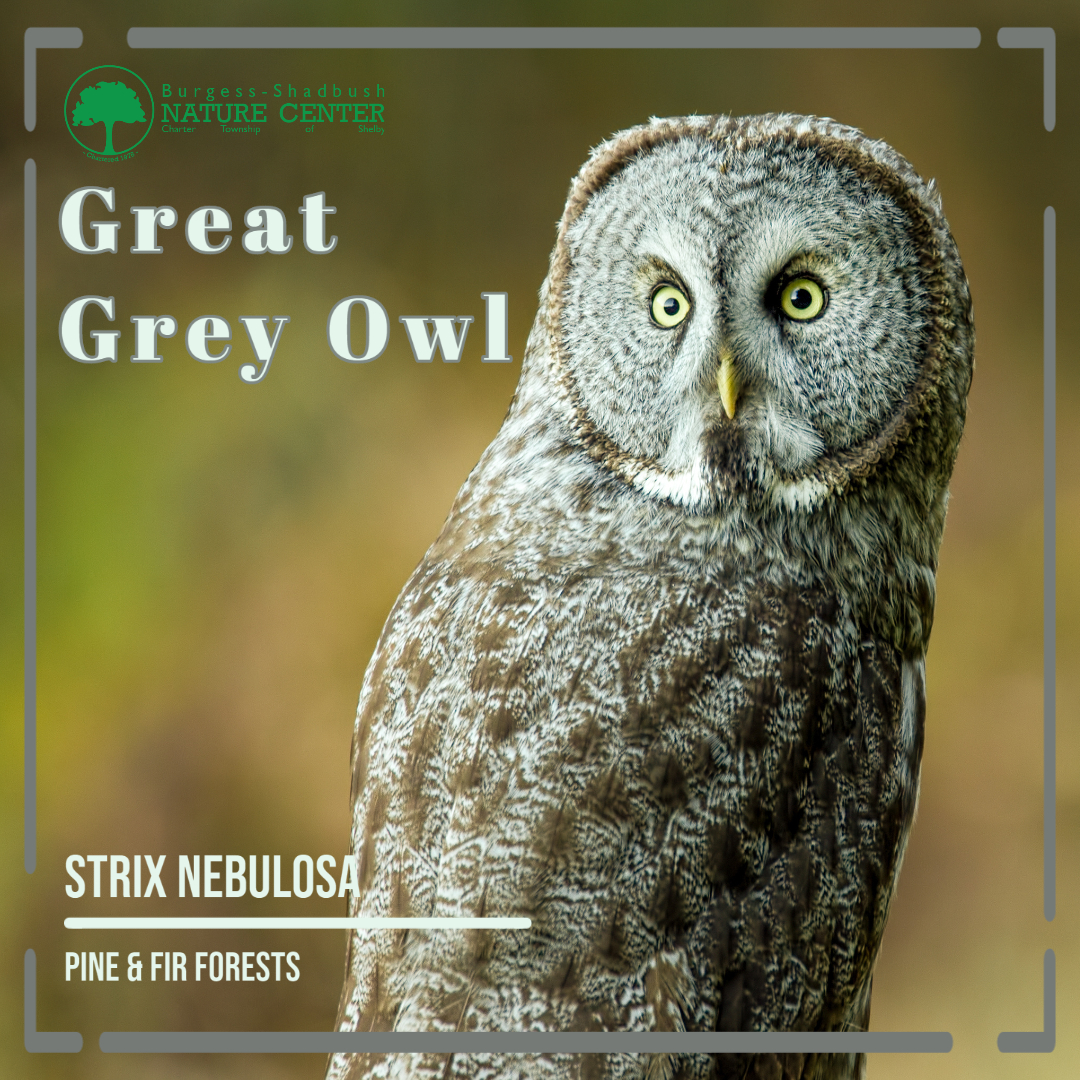 Great Grey Owl
Great Grey Owl
Great Gray Owls (Strix nebulosa) are the largest owl species in North America. Females are larger than males, with a wingspan over 4 feet. Both females and males look similar with large, rounded, half-domed head with a flat face and no ear tufts. White streaks make an "x" between their eyes.
The great gray makes territorial announcements and calls its mate with an appropriately owlish whoo-whoo-whoo, repeated softly in a low pitch every 15 to 30 seconds, usually at night.
These owls have excellent eyesight and hearing, allowing them to prey on mice, voles and other small animals.
Indigo Bunting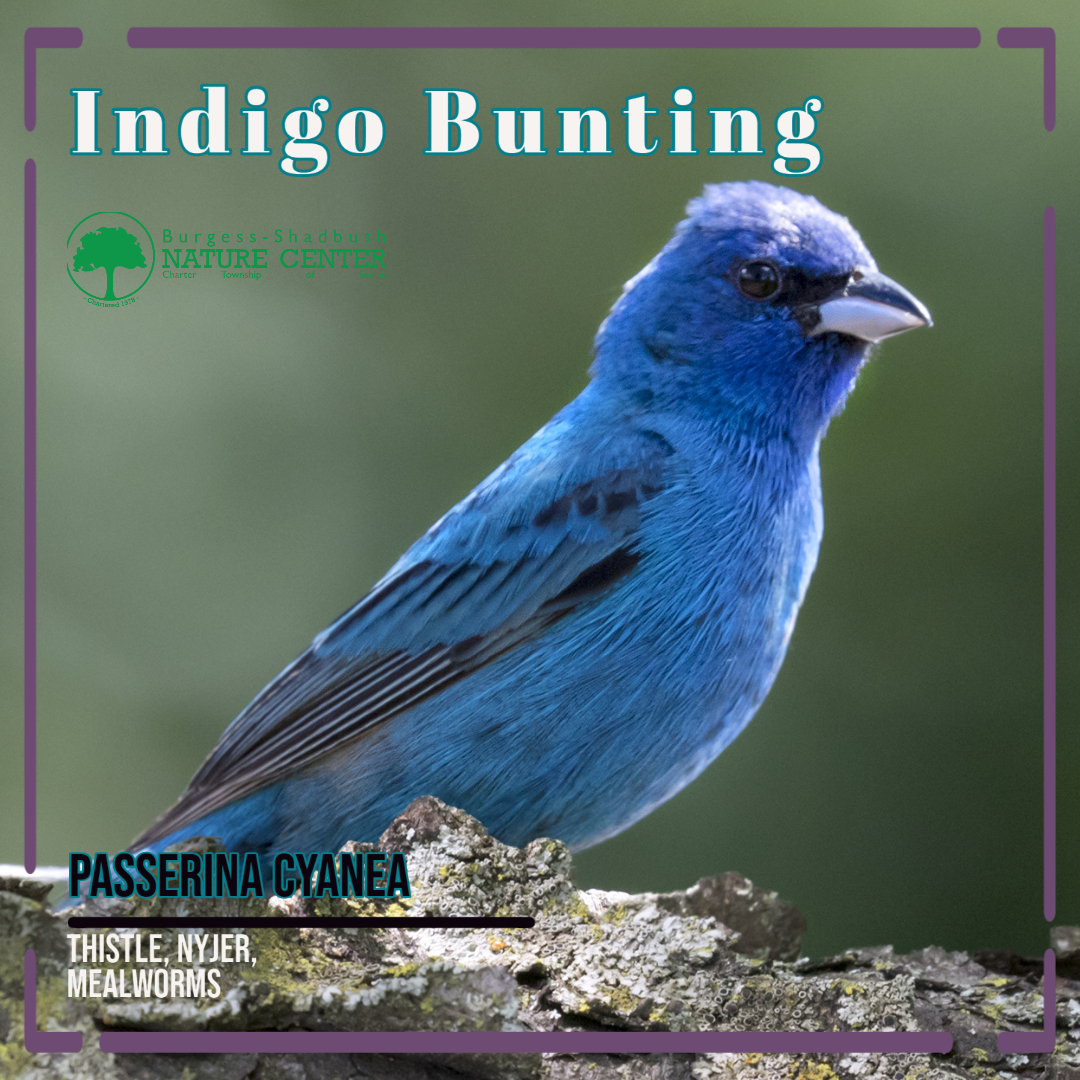
The beautiful indigo bunting (Passerina cyanea) is nicknamed "blue canary". They can be found in late spring and throughout the summer in weedy fields and shrub areas near trees.
Female indigo buntings are, not surprisingly, less colorful, taking on multiple tan and brown colors. They do share a bi-color beak with their male counterpart, with their beak dark on top and white on the bottom.
You can attract indigo buntings with small seeds like thistle or nyjer. They also love insects so mealworms may attract them as well.
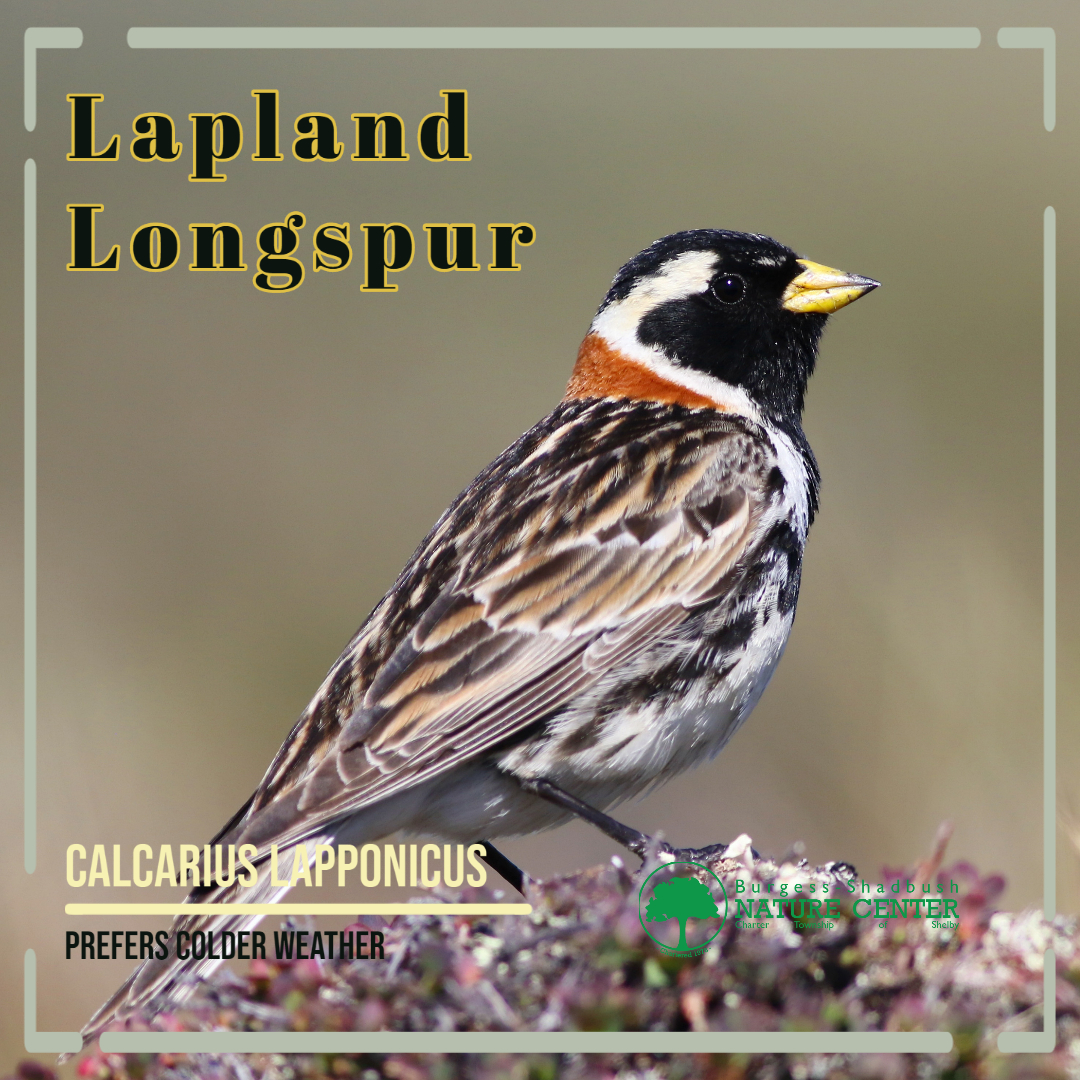 Lapland Longspur
Lapland Longspur
You're more likely to see the lapland longspur (Calcarius lapponicus) during the winter and migration period here in Michigan. They prefer arctic tundras and migrate in the winter to colder plains and prairies.
They feed mostly on seeds in the winter and walk or run across the ground. Their brown coloring masks them from predators like the arctic fox. In the summer, they also eat insects like flies, beetles, caterpillars and spiders.
Northern Flicker
The northern flicker (Colaptes auratus) is a large, brown woodpecker that prefers to feed on the ground. They mainly eat ants and beetles, digging in the ground with their beak instead of in trees.
Like other woodpeckers, they usually nest in holes in trees but can occasionally be found in old ground burrows leftover from kingfishers or bank swallows.
You won't normally find a northern flicker at a bird feeder but if you put up a nesting box, you might attract a breeding pair. Some have luck with sunflower seeds, safflower seeds, suet or peanuts.
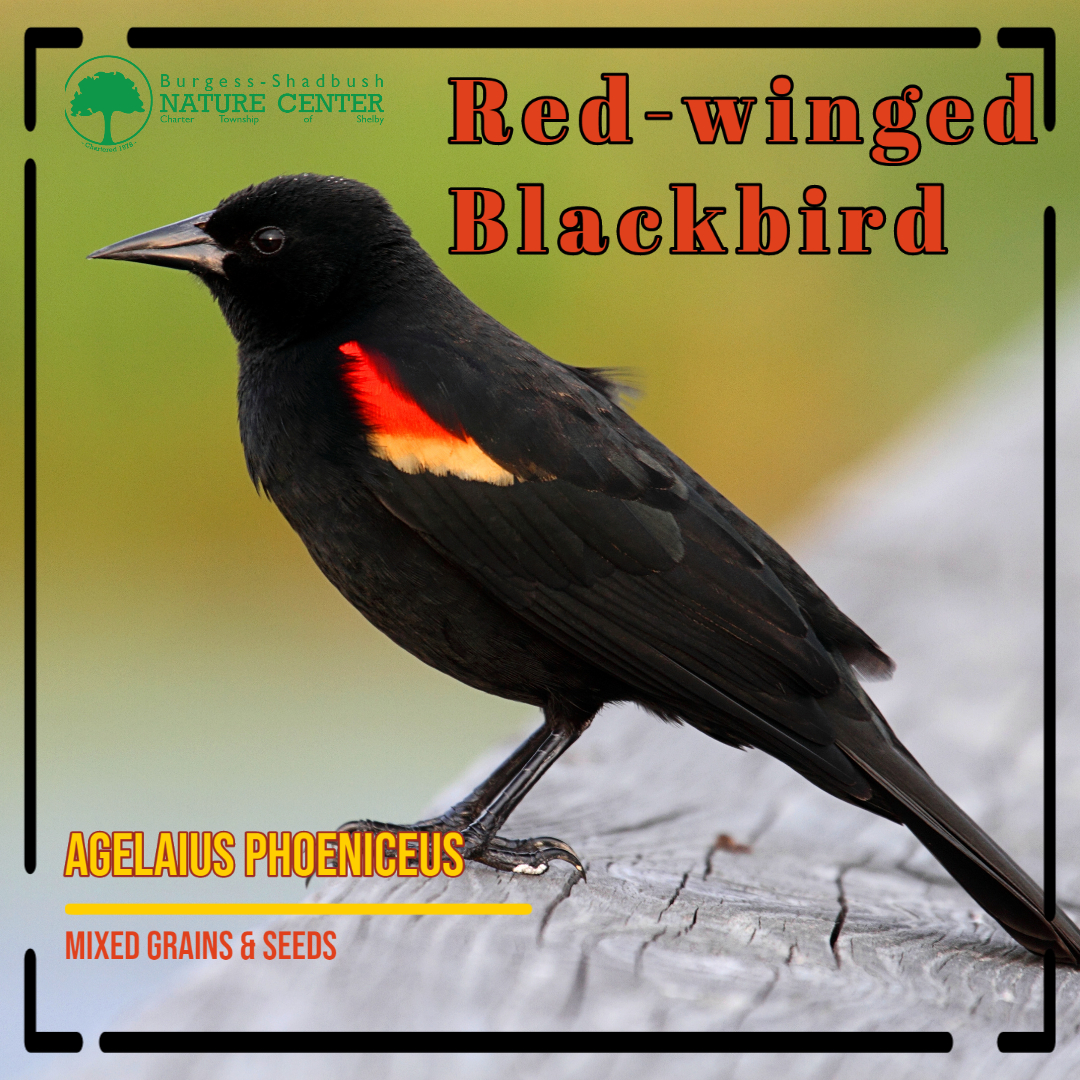 Red-Winged Blackbird
Red-Winged Blackbird
You've probably seen the red-winged blackbird (Agelaius phoeniceus) along roadsides, on telephone wires and in the parks. Their identifiable by the red and yellow shoulder patches on their wing that stands out brilliantly against their black feathers.
Female red-winged blackbirds are less colorful with an array of browns in their feathers resembling sparrows.
Red-winged blackbirds like standing water like in wetland arrays. You'll often find them on cattails.
If you want to attract these beautiful birds to your yard, put mixed grain and seeds in your feeder/ You can also spread some on the ground or deck where these guys prefer to feed.
Red-eyed Vireo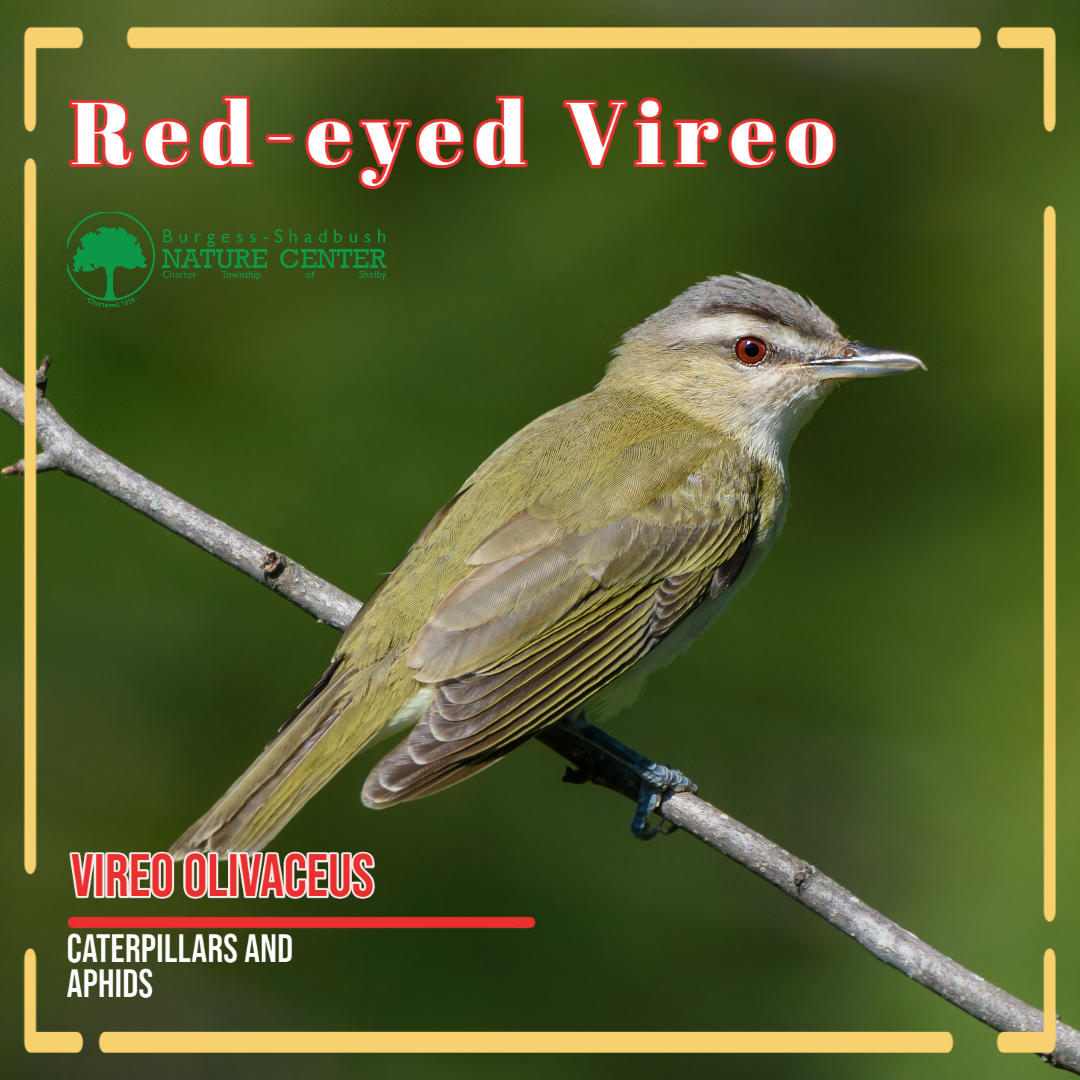
The red-eyed vireo is a small songbird with an olive-green body and red iris. The red in their iris doesn't develop until the end of their first winter. They also have a dark blackish line through their eyes and an "eyebrow".
They eat insects, preferring caterpillars and aphids by plucking them from the ground or plants. They also eat berries, especially before migration to South America.
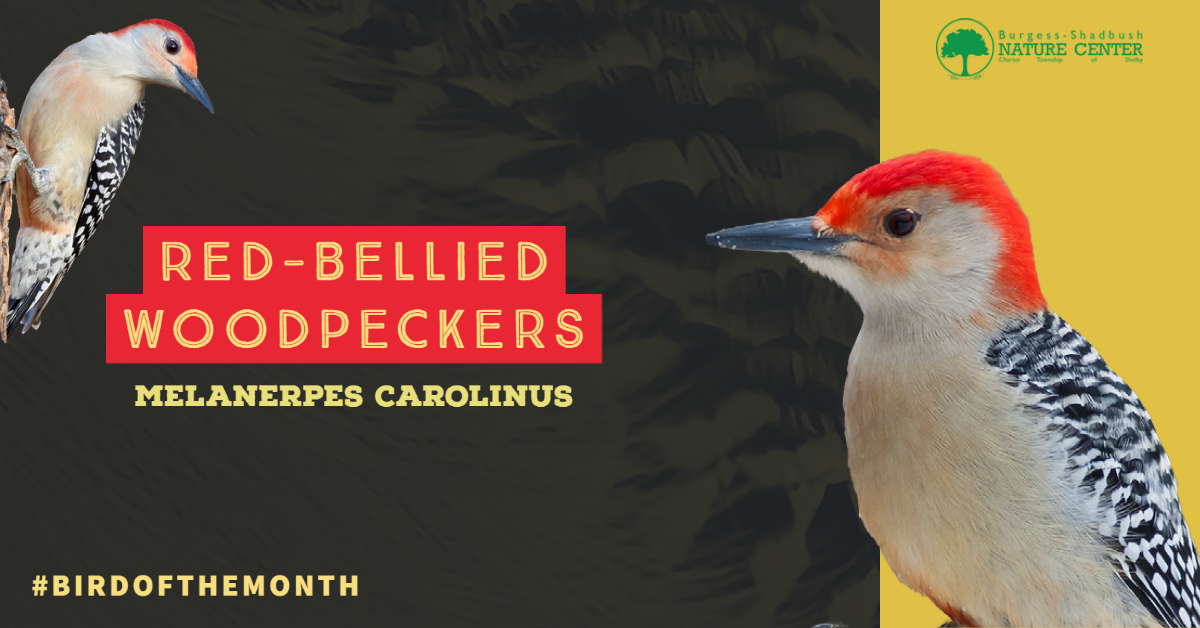 Red-Bellied Woodpecker
Red-Bellied Woodpecker
Red-bellied Woodpeckers are medium-sized birds with strikingly barred backs and gleaming red caps. They can stick out their tongue nearly 2 inches past the end of their beak! The tip is barbed and the bird’s spit is sticky, making it easier to snatch prey from the holes they make in trees. If you live near any wooded patches, you may be able to attract this dazzling bird to your backyard using feeders filled with suet (in winter), peanuts, and sometimes sunflower seeds!
Turkey Vulture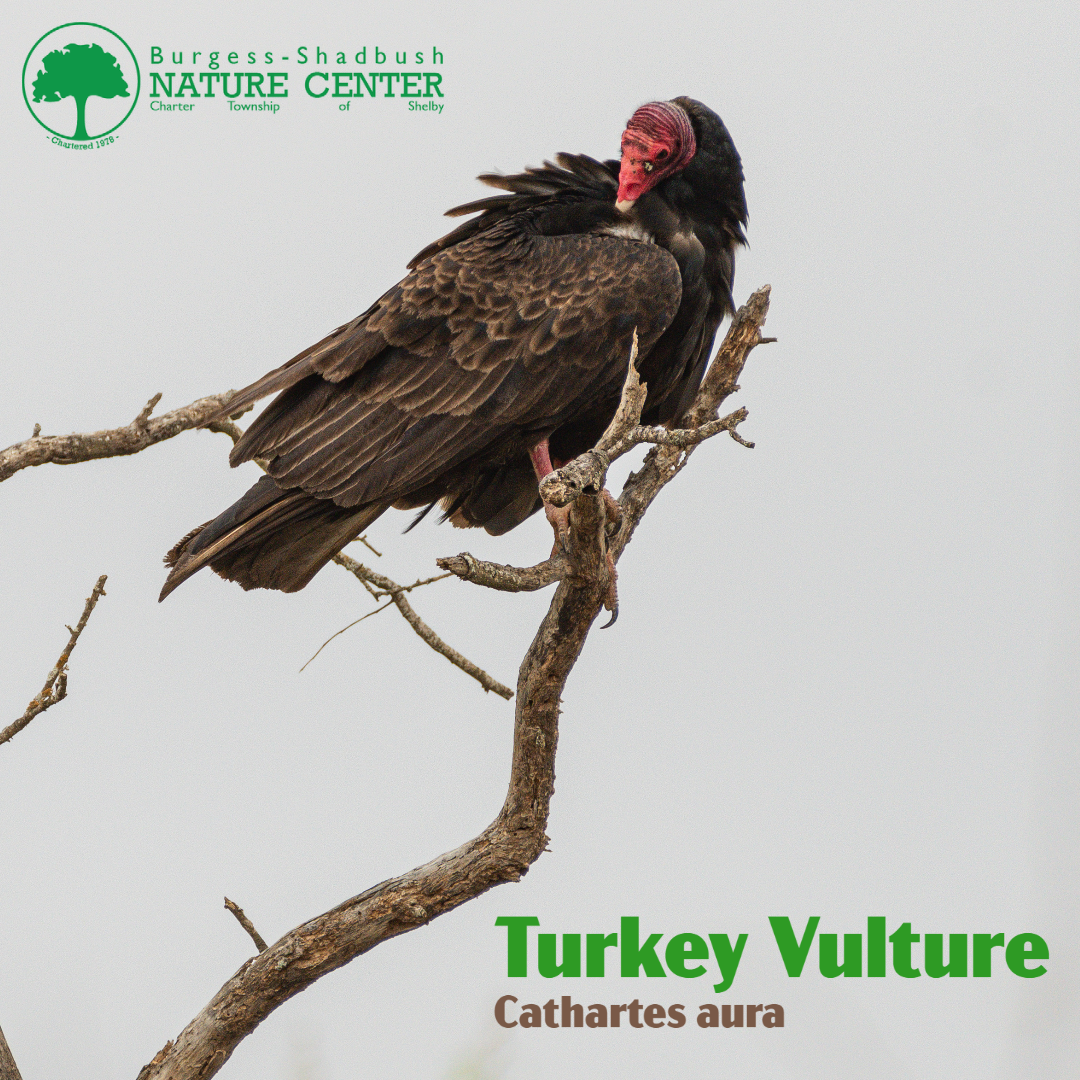
One of the earliest signs of spring is the sight of a Turkey Vulture soaring overhead!
While the bulk of the migration north begins in mid-March, you may see these birds as early as February. You can identify a soaring turkey vulture by their long, broad wings with long “fingers” at their wingtips. You may also spot their pink, naked head. While often considered ugly, these birds play a vital role in our ecosystem as nature’s clean-up crew—breaking down organic material (dead animals) and recycling them back into the ecosystem as nutrients.
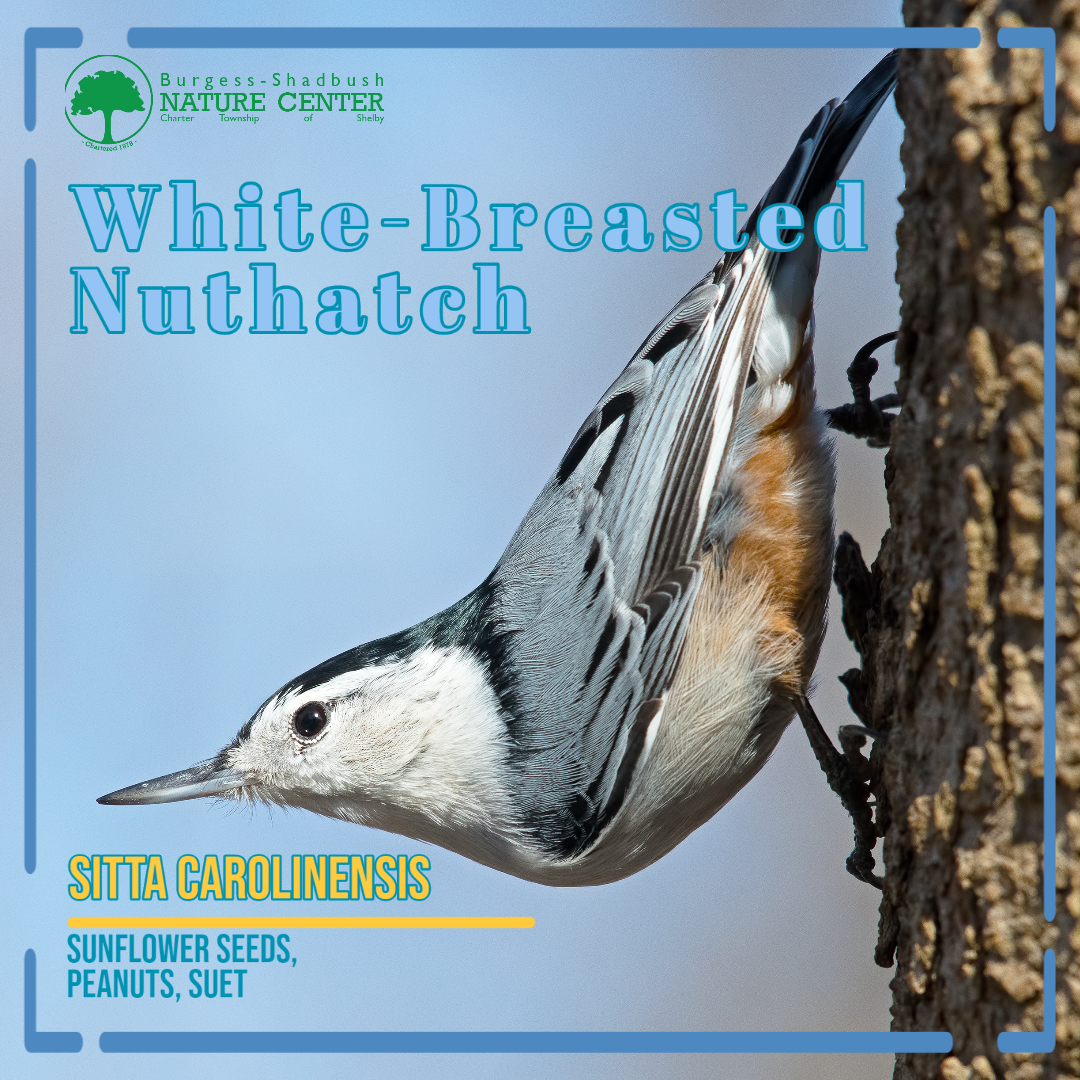 White-Breasted Nuthatch
White-Breasted Nuthatch
The white-breasted nuthatch (Sitta carolinensis) is a common feeder bird. They like to make quick trips to and from the feeder, storing seeds for winter in the bark of nearby trees.
They move quickly and often at odd angles while vertical. In winter, they join flocks lead by chickadees and titmice, likely to make it easier for them to find food.
You can attract them with sunflower seeds, peanuts and suet.
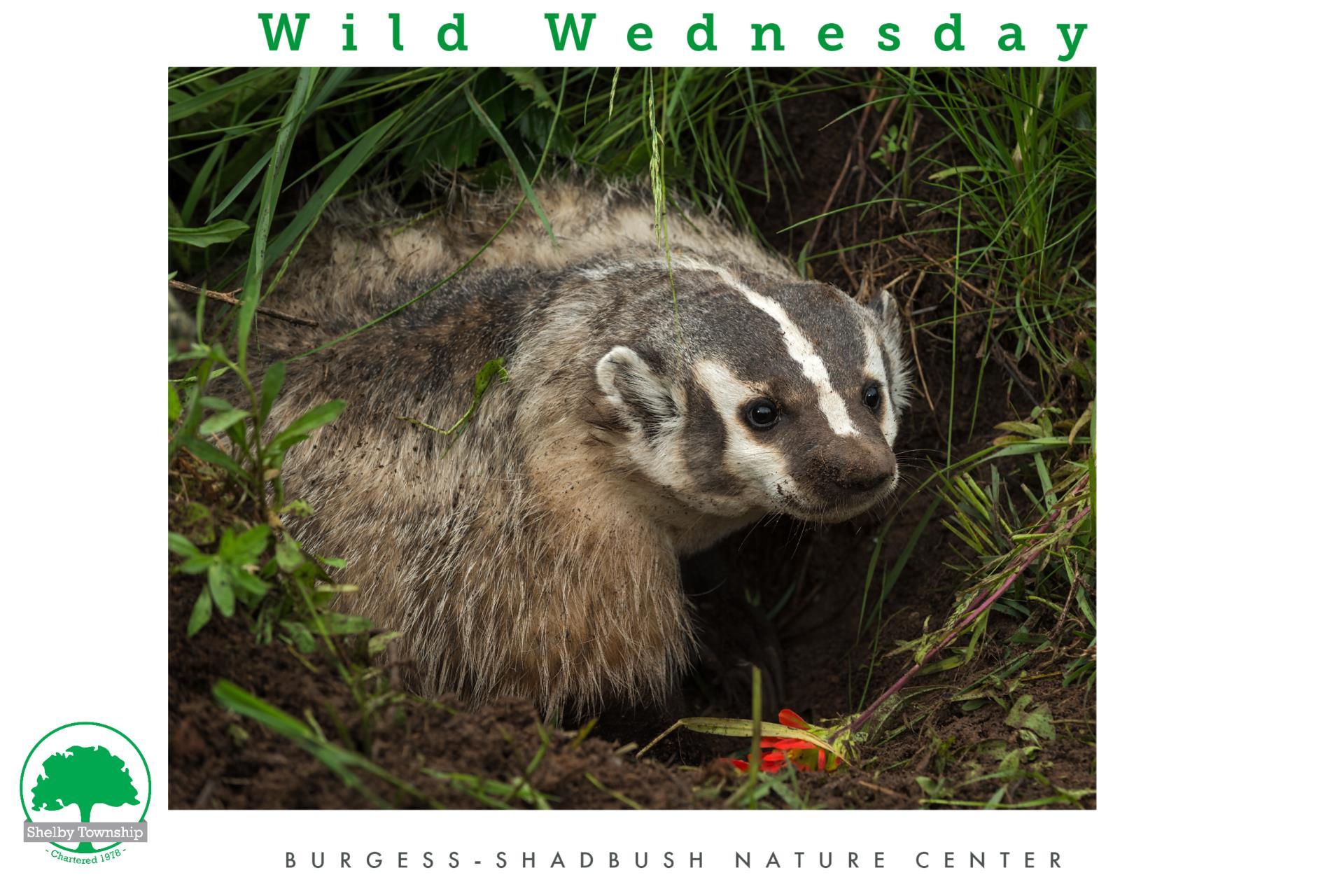 American Badger
American Badger
American badgers (Taxidea taxus) is a burrowing mammal of the weasel family. They use underground burrows for resting, denning and catching prey. They're generally found in grasslands, deserts, dry forests and agricultural areas.
Their burrow systems allows them to forage underground for ground squirrels, prairie dogs, marmots and pocket gophers. Their large homes may overlap with other badgers.
Predators include gray wolves, coyotes, bears and cougars but for many in populated areas, traffic is a significant danger.
Banded Tussock Moth
The banded tussock moth (Halysidota tessellaris) may look plain at first glance, but upon closer look, you may find some more color and beauty in it.
These moths, also called pale tiger moths, are light brown with a dark edge. If you look closely, you can see a yellow body with blue-green lines. Larva (caterpillars) are covered in long setae (hair-like structure), making them look bushy. Because of the plants they ingest, people with sensitive skin may have an adverse reaction to touching the caterpillar.
They regurgitate on decaying plants, liquifying them. It may be gross to us, but these liquids are rich in alkaloid compounds.
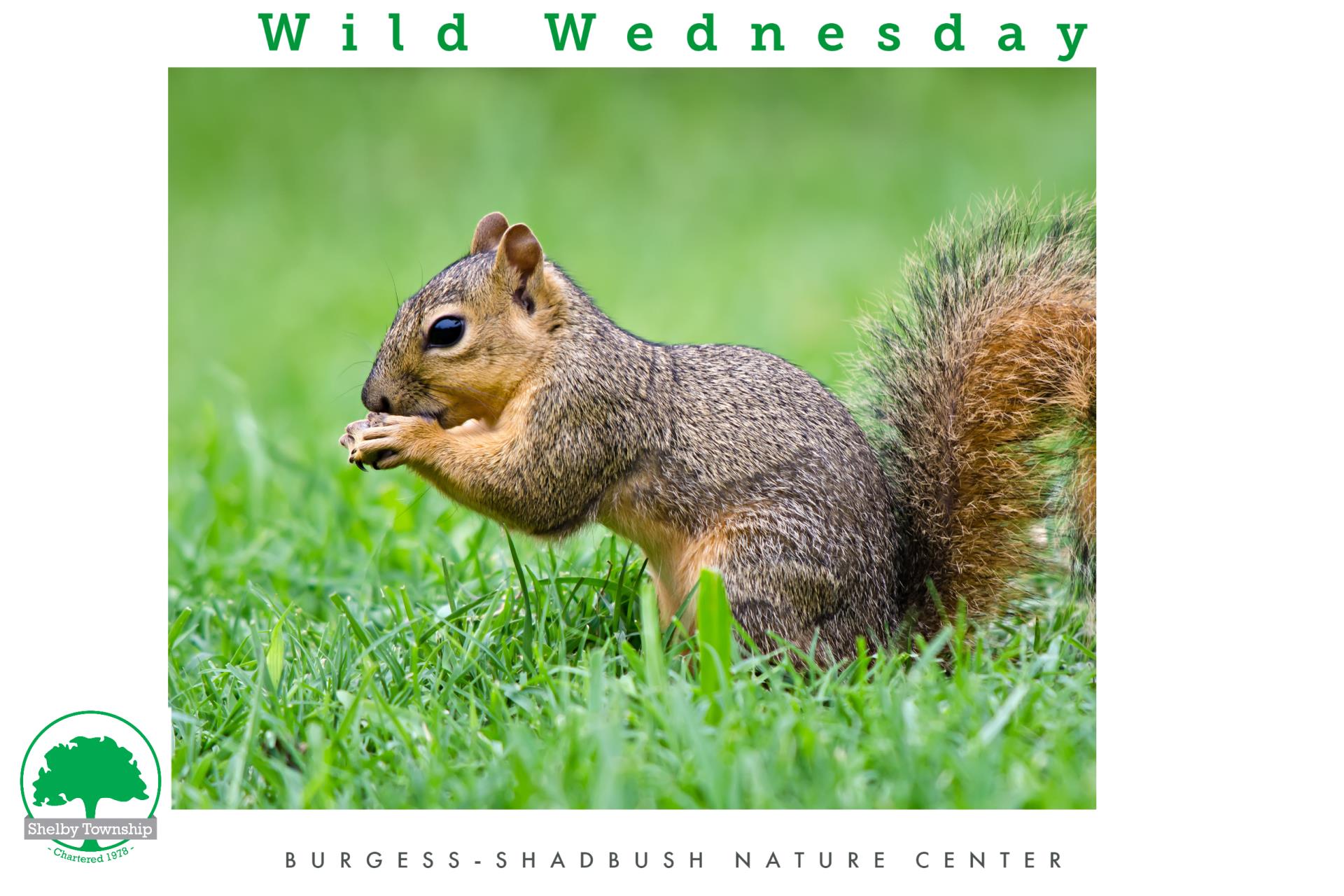 Eastern Fox Squirrel
Eastern Fox Squirrel
Chances are you're very familiar with the eastern fox squirrel (Sciurus niger). Not only are they prominent in Michigan but they're found throughout the eastern and central US as well as Mexico and Canada.
Fox squirrels have sharp recurved claws, well developed digits and forearms to make them agile in the trees. They care for their young in a nest for six weeks. They like to eat a variety of leaves, seeds, grains, nuts and fruit. Because of their diet, they play a big part in shaping forests and provide important prey for smaller predators like hawks, owls and snakes.
Eastern Massasauga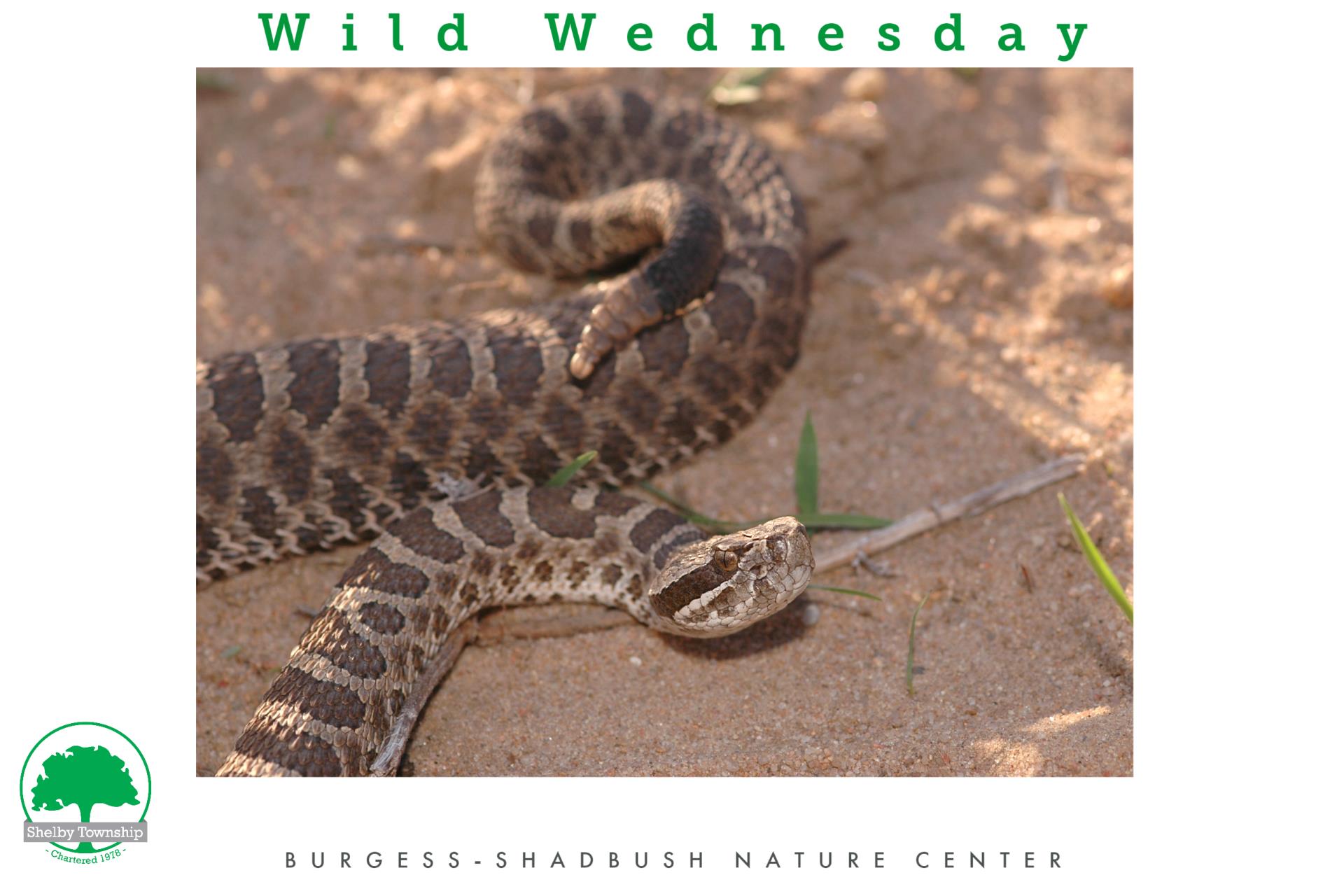
Are you afraid of snakes? Then you may want to stay out of the wetlands and open fields where the Eastern Massasauga (Sistrurus catenatus) lives. This small rattlesnake uses wetlands and other moist habitats during the fall, winter and spring but will move to drier open fields.
The eastern massasauga is the only venomous snake in Michigan. Humans aren't on their hunting list, though. They mostly feed on small mammals like voles, moles, mice and shrews.
Their population has been declining due to the loss of wetland habitat and is considered a threatened species by the US Fish and Wildlife Service under the Endangered Species Act.
If you do spot one of these snakes, keep your distance and give it space. Keep pets away too. You can report your siting to the DNR on their website, michigan.gov/dnr.
 Fisher
Fisher
This creature may look adorable but like all wild animals, it's best if left alone.
Fishers (Martes pennanti) are part of the weasel family and only found in North America. They prefer coniferous (trees with needles) forests but can be found in a mixed and deciduous (trees that shed their leaves every year) forests.
Fishers love climbing trees and are agile and quick though they usually do their hunting on the ground. They use logs, hollow trees, stumps, ground holes, brush piles and nests of branches for their "resting sites" or dens. They also can have snow dens during the winter.
These animals are medium-sized predators, seeking prey in the holes in the ground, hollow trees and other small areas. They eat mice, porcupines, squirrels, snowshoe hares, birds and shrews. They may also feed on fruits and berries.
Their natural predators are hawks, red foxes, lynx and bobcats. They can also be trapped and killed for their pelt by humans, though fisher hunting has declined. These days, their only interaction with humans may be in certain suburban areas where they've become used to human presence and prey on small pets.
Golden Garden Spider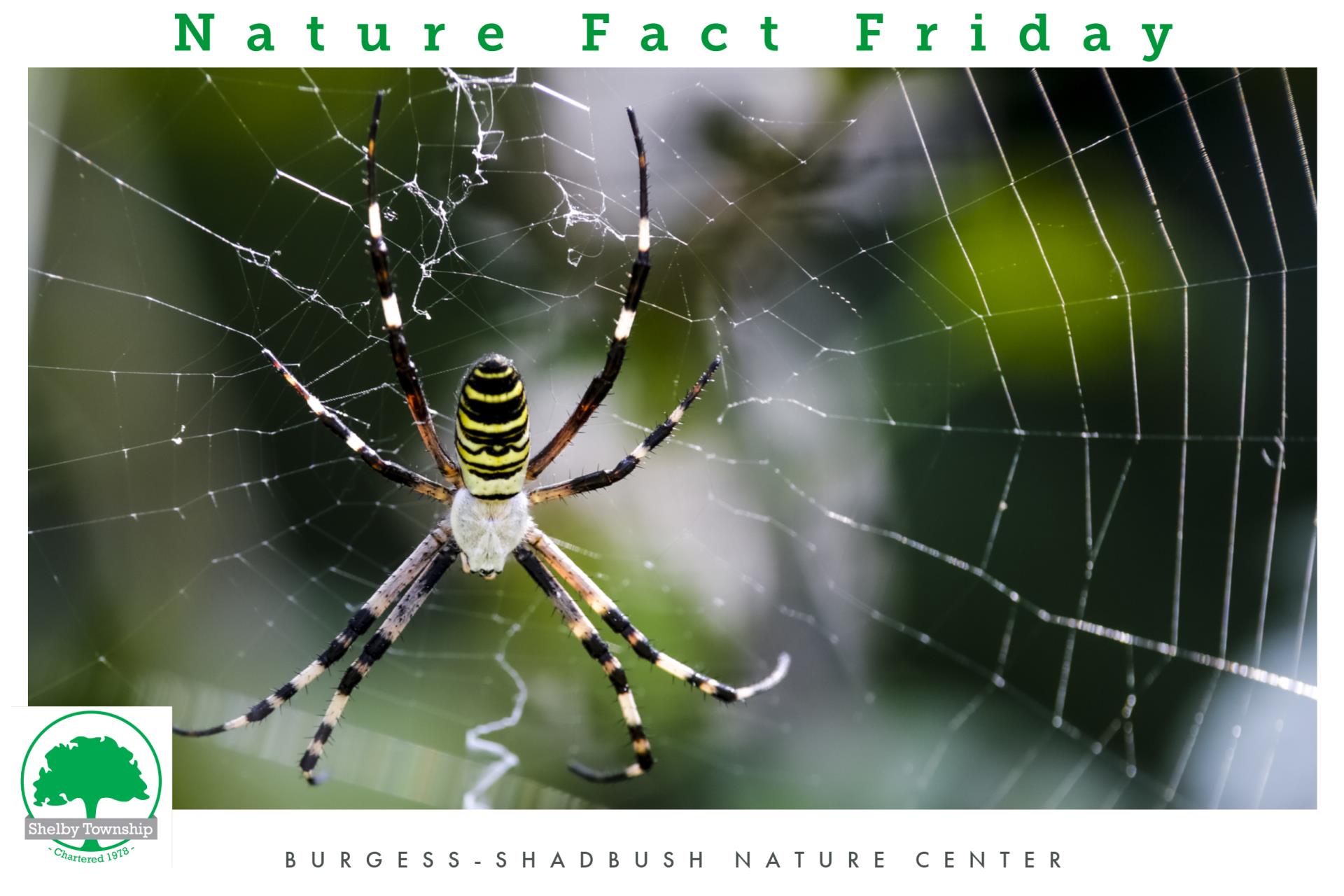
The golden garden spider (argiope aurantia) is common in Michigan and goes by many names: black and yellow garden spider, black and yellow argiope, garden spider, writing spider, etc.
They live in gardens, orchards, forest edges, old fields and farms. If they feel threatened while sitting on their web, thy will throw their bodies into wild circles making them look 2-3 times bigger to scare off predators.
Like most Michigan spiders, they have a mild venom they inject when they bite but it's usually so mild it has little to no effect on humans.
 Gray Fox
Gray Fox
The gray fox (Urocyon cinereoargenteus) is often mistaken for our other Michigan friend, the red fox. Besides the color difference, however, gray foxes have oval eyes compared to a red fox's slighted eyes. They are also shorter, stockier and have a rougher fur.
They come in a variety of colors besides gray and are often a mix of gray, brown, white, red and black fur. They have a distinctive black stripe running along the top of their tail and at the corner of their eyes.
These foxes are foragers and will eat most meat, fruit, vegetables and insects, though they prefer small mammals.
Honey Mushroom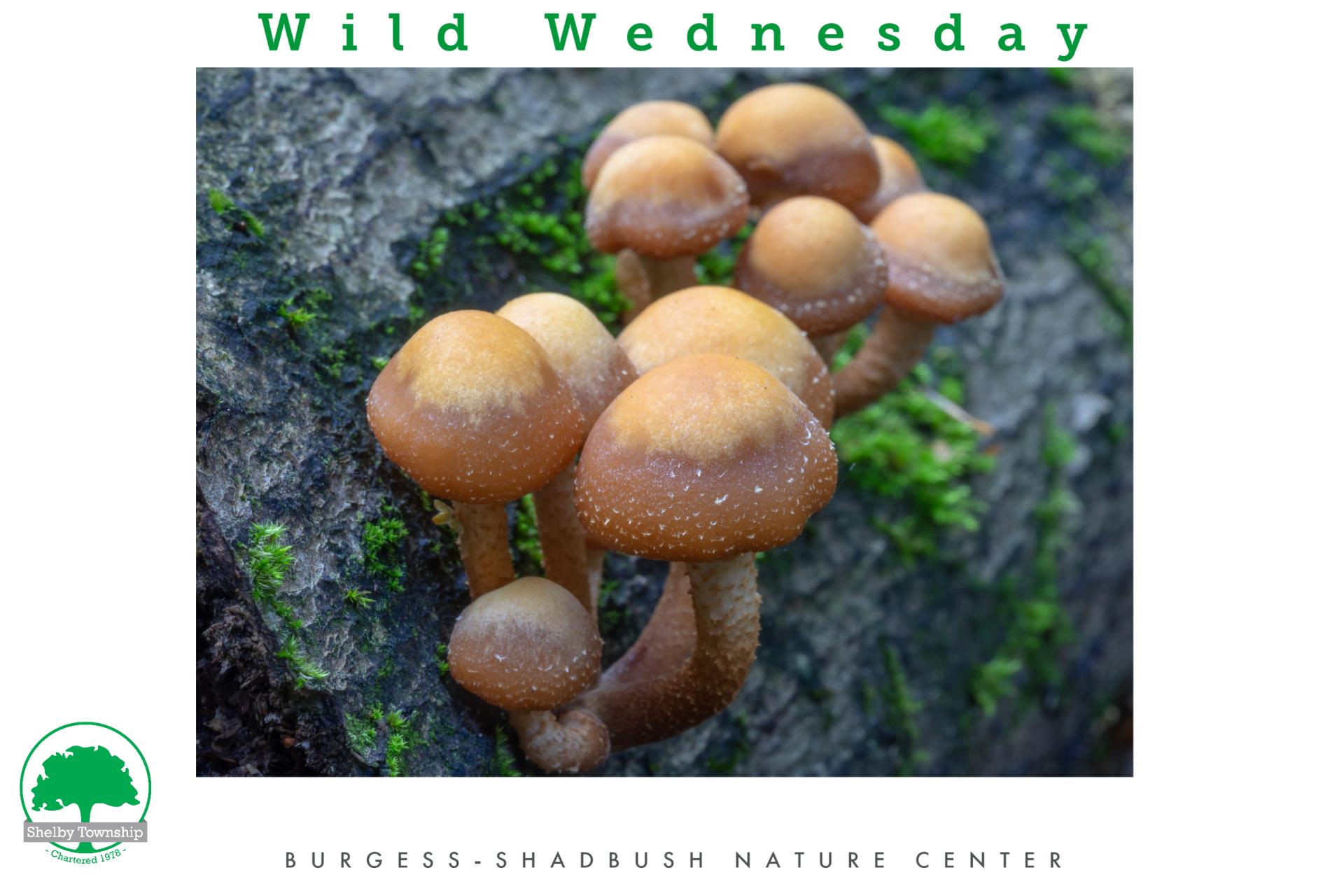
Ready for something WILD?
Michigan used to be home to the world's largest organism. No, not the blue whale, but a colony of honey mushrooms (Armillaria gallica), also known as "humongous fungus." In Crystal Creek, Michigan, the mushroom is believed to be 2,500 years old, covers 90 acres of land in the Upper Peninsula and weighs 440 tons (three blue whales).
It's a subterranean fungus that produces yellow-brown "fruit bodies" covered in small scales. The majority of the fungus lives underground in the form of long, black tendrils calls "rhizomorphs."
While the Michigan fungus used to be the largest for a couple of decades, we've since crowned a new winner. The Armillaria ostoyae fungus, found in 1998, lives in Oregon and covers 2,200 acres ( 3.5 miles).
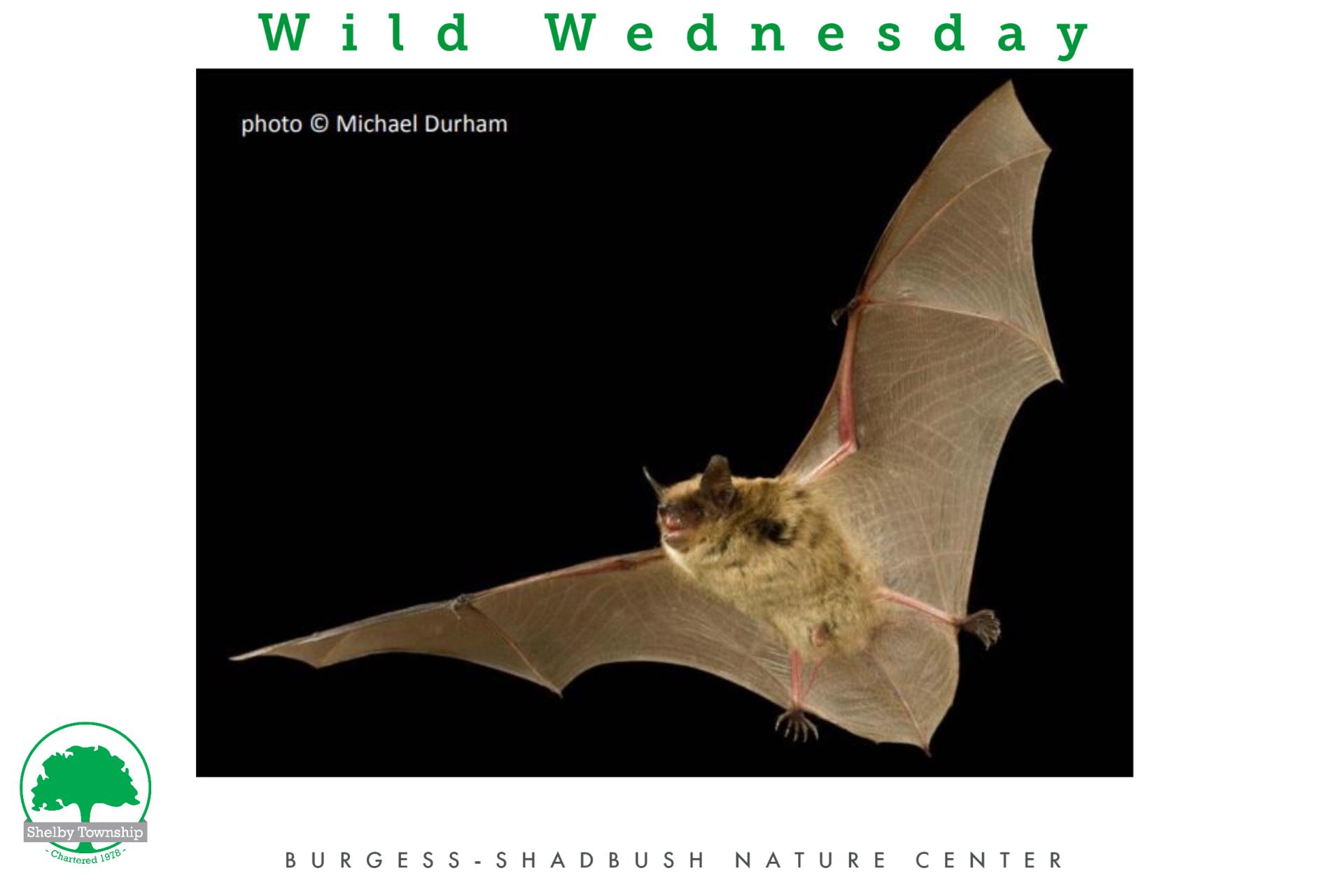 Little Brown Bat
Little Brown Bat
Have no fear, the little brown bat (Myotis lucifugus) is here to eat the peskiest pests. This small mouse-eared mammal eats anthropods like spiders, mosquitoes, flies and ants, among others.
They have a lifespan of around 6.5 years, and pups (baby bats) reach maturity by three weeks old. You'll only encounter them at night as they are nocturnal hunters and prefer to roost during the day.
Their few natural predators are owls and raccoons. Their biggest threat is the destruction of their natural habitat, leaving them few places to nest.
People tend to dislike these creatures because of their waste or the threat of rabies. But little brown bats rarely test positive for rabies.
You can support them by using bat houses to shelter them but keep them out of your home.
Mudpuppy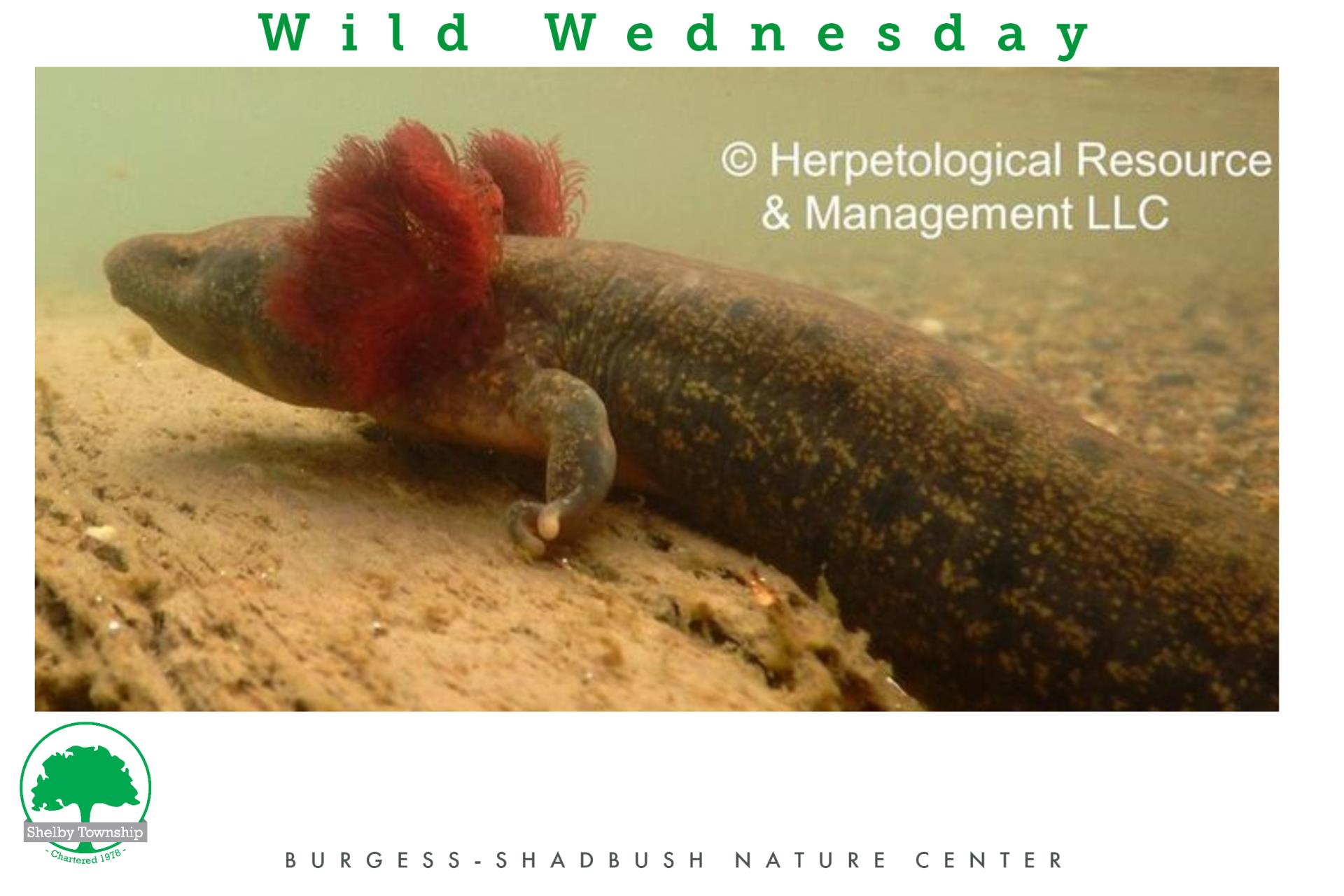
Mudpuppies (Necturus maculosus) are actually salamanders that live on the bottom of lakes, rivers and ponds. They're one of the few kinds of salamanders that make noise.
Also called waterdogs, mudpuppies are amphibians. They have lungs and can gulp air but rely on their external gills for oxygen. They live entirely in the water, hiding in vegetation and under rocks.
They're very recognizable with their red flowery gills. They can grow between 8 to 13 inches and live around 11 years. They are carnivorous creatures and eat insects, mollusks, small fish, other amphibians, earthworms and spiders.
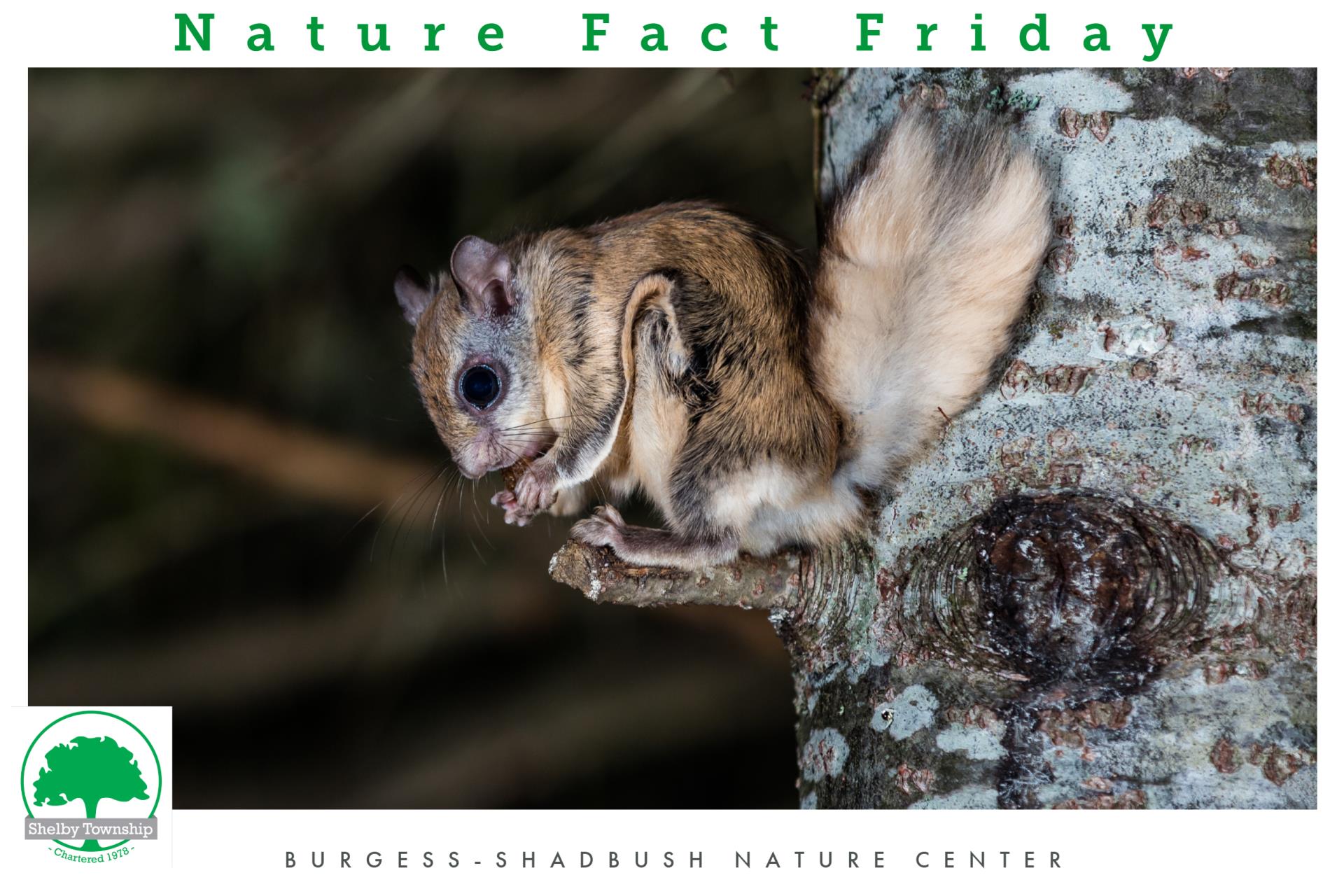 Northern Flying Squirrel
Northern Flying Squirrel
The northern flying squirrel (Glaucomys sabrinus) is one of the only three flying squirrels in America.
Their diet is very similar to normal squirrels: they eat nuts, acorns, fungi and lichen. They also eat seasonal items like berries, sap, buds and occasionally insects or bird eggs. Unlike most squirrels, though, is that their diets are based around the lichen and fungi they eat which is more abundant than most nuts and seeds.
Flying squirrels play a large role in helping fungi populations flourish by spreading the spores as they forage.
They can be very difficult to locate and observe but they can be heard stealing from bird feeders at night.
Porcupines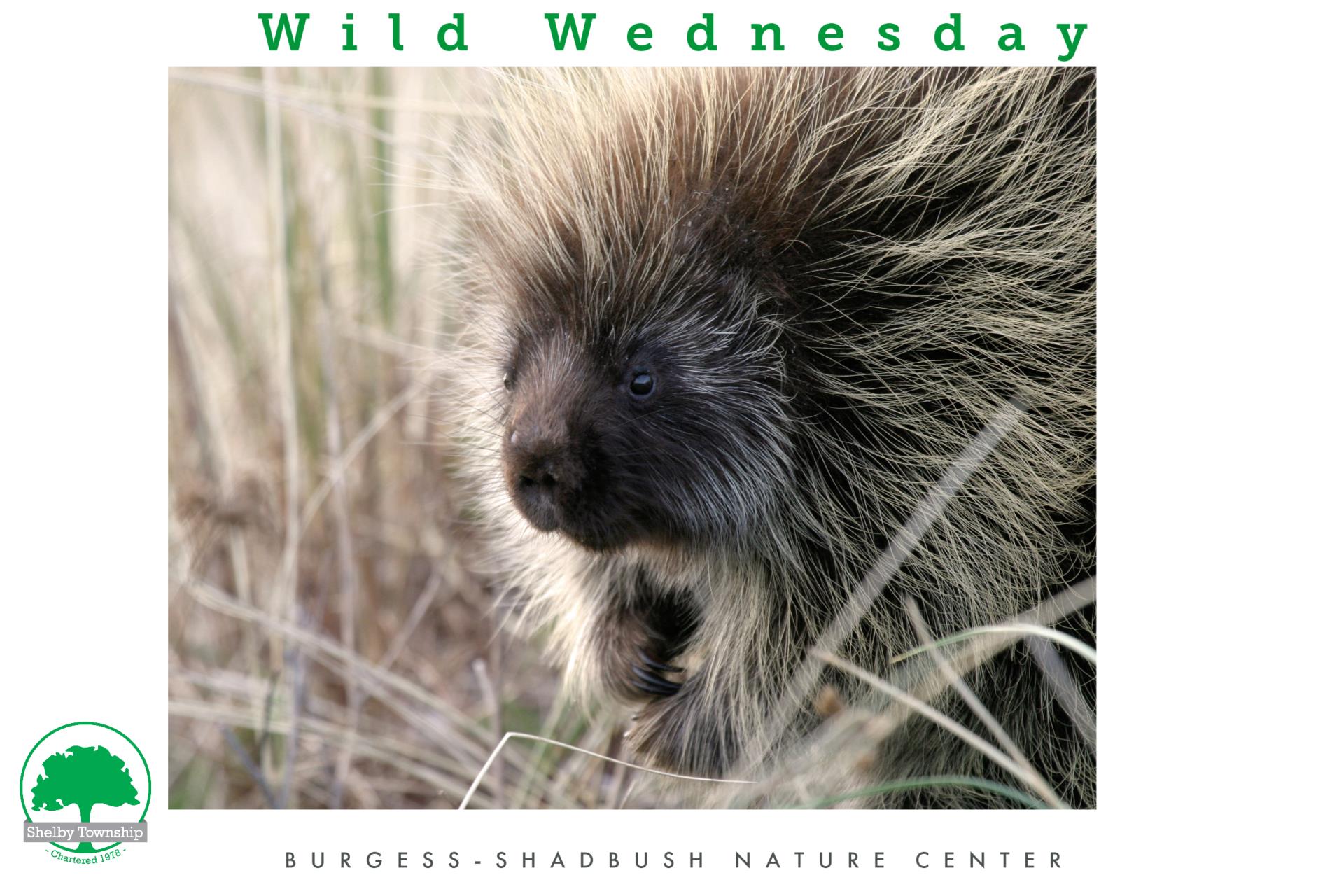
Porcupines (Erethizon dorsatum) live in forest and desert areas. It's the second-largest rodent in the U.S. They have a small head, a large, rounded body and thick, muscular tail.
Most people are familiar with the stiff guard hairs and a band of sharp quills that cover their bodies. These quills have a tiny barb that attaches to predators, making them difficult for them to remove.
Porcupines are nocturnal and feed on leaves, twigs, green plants and tree bark. Predators include coyote, mountain lions and fisher.
 Pumpkinseed Sunfish
Pumpkinseed Sunfish
Pumpkinseed Sunfish (Lepomis gibbosus) are a common native fish in the Great Lakes area. They have a speckled orange, yellow, blue and green body with a tell-tale black and red marking by their gills.
You can tell a pumpkinseed sunfish from a bluegill sunfish from the aqua-blue lines radiating from the mouth and nose, and they typically have a bright orange belly.
You can catch them rather easily with a variety of baits, lures or flies and are more willing to take small fish or minnows than bluegills.
Typically young pumpkinseeds eat zooplankton and algae. As they grow, they begin eating smaller fish, aquatic insects and some plants.
Have you caught a sunfish while fishing? It's probable. Take a closer look next time you find one and admire their beauty.
Rainbow Trout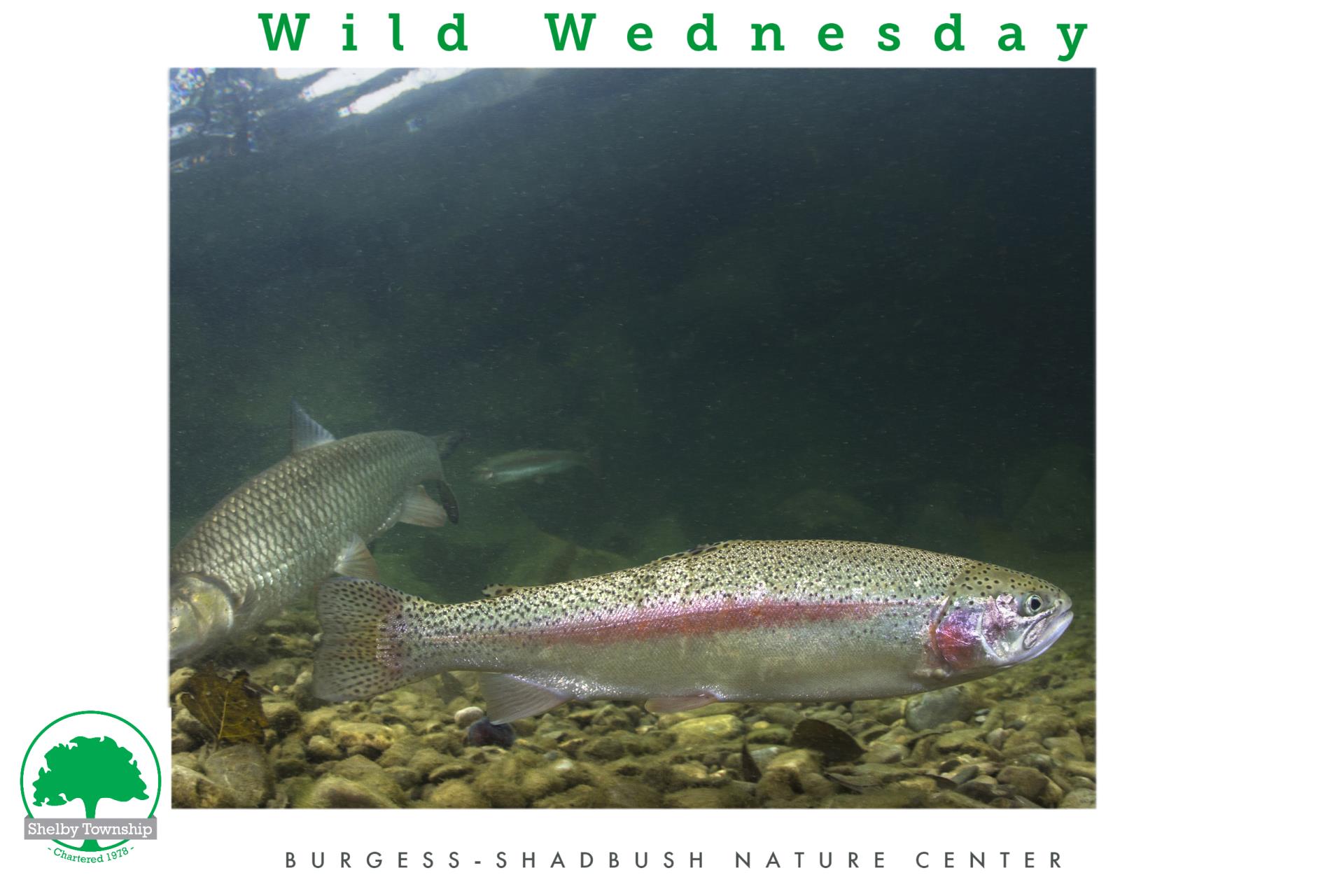
Rainbow trout (Oncorhynchus mykiss) are not native to Michigan. In 1876, rainbow trout eggs were imported from California where they lived in the Pacific watershed. They were first stocked in the Au Sable River and then Lake Michigan. Now, you can find rainbow trout all over the state.
Michigan rainbow trout is typically referred to as “steelhead”. This refers to the coastal rainbow trout (salt water) that return to fresh water to spawn. Of course the trout in Michigan are all fresh water.
Rainbow trout eat whatever they can find, preying on larval, pupal and adult forms of aquatic insects. They will also eat fish eggs and ground insects that might fall into the water (like grasshoppers).
Red-breasted Grosbeak
The rose-breasted grosbeak (Pheucticus ludovicianus) is a seed-eating bird from the cardinal family. Males are colorful with the signature red breast and black head and back while females tend to be brown without their red markings.
You can find them in the northern parts of North America. They migrated during the winter to more tropical climates like Mexico and Central America. They eat elderberry, blackberry and raspberry along with weed seeds like foxtail, milkweed and sunflowers, among others. They also enjoy a variety of insects.
Rose-breasted grosbeaks don't get along well with blue jays, a common nest predator. They also suffer attacks from hawks and squirrels.
Have you see one of these beautiful birds around your yard?
Skunk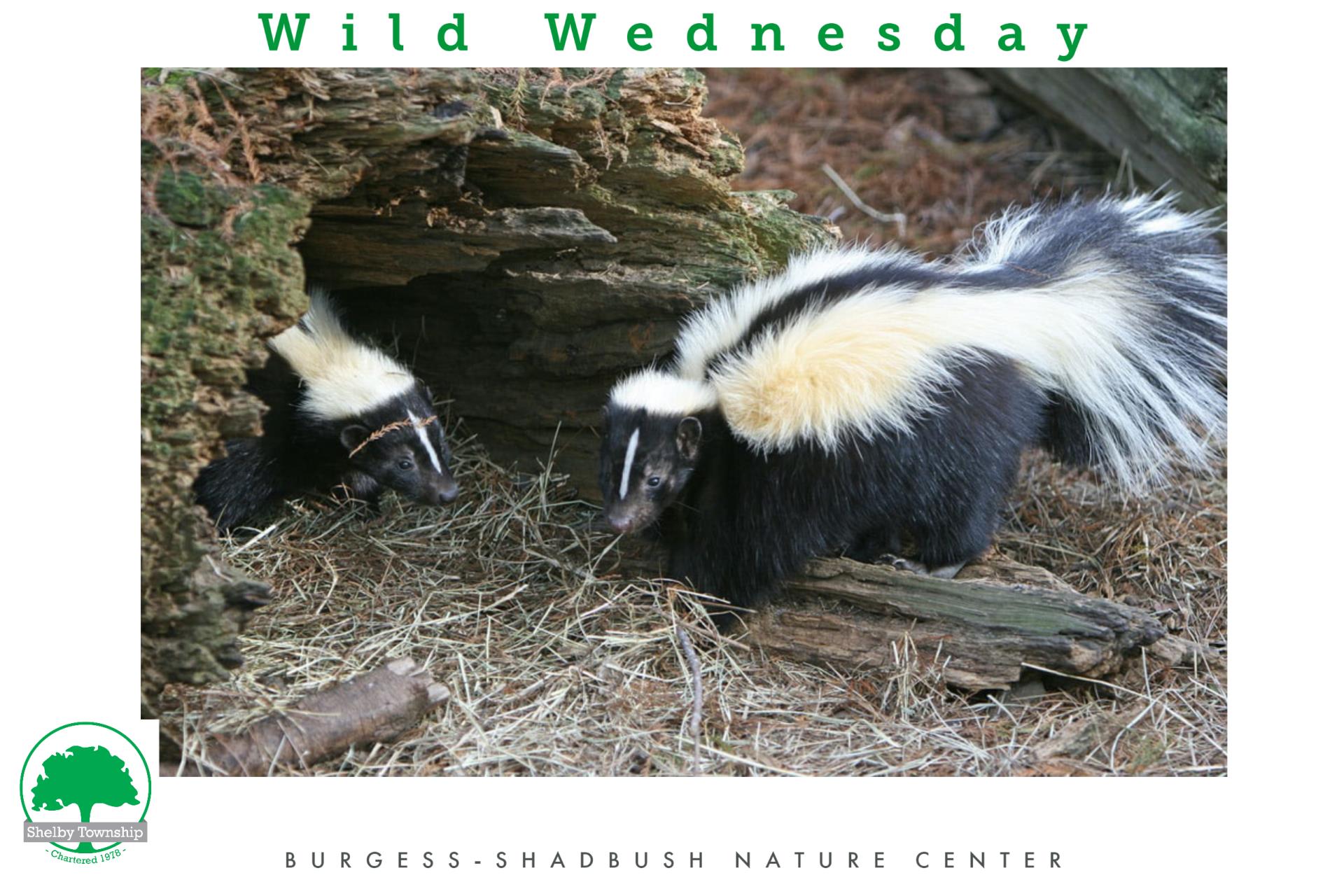
You're probably familiar with out Wild Wednesday guest of honor but do you know much about them besides their stinky reputation?
Stripped skunks (Mephitis mephitis) are found in forests, grasslands, deserts and, of course, developed communities. They're recognizable from their black head and two white strips that run down their body. They also have a bushy tail.
Their anal glands under their tail contain a toxic musk. They use this to ward off predators. The spray can cause pain and temporary blindness, so it's best to keep yourself and pets away if you see one. Their chief predator is the great horned owl.
Skunks eat plants, insects, small animals and eggs. They're nocturnal and can live 2-3 years in the wild.
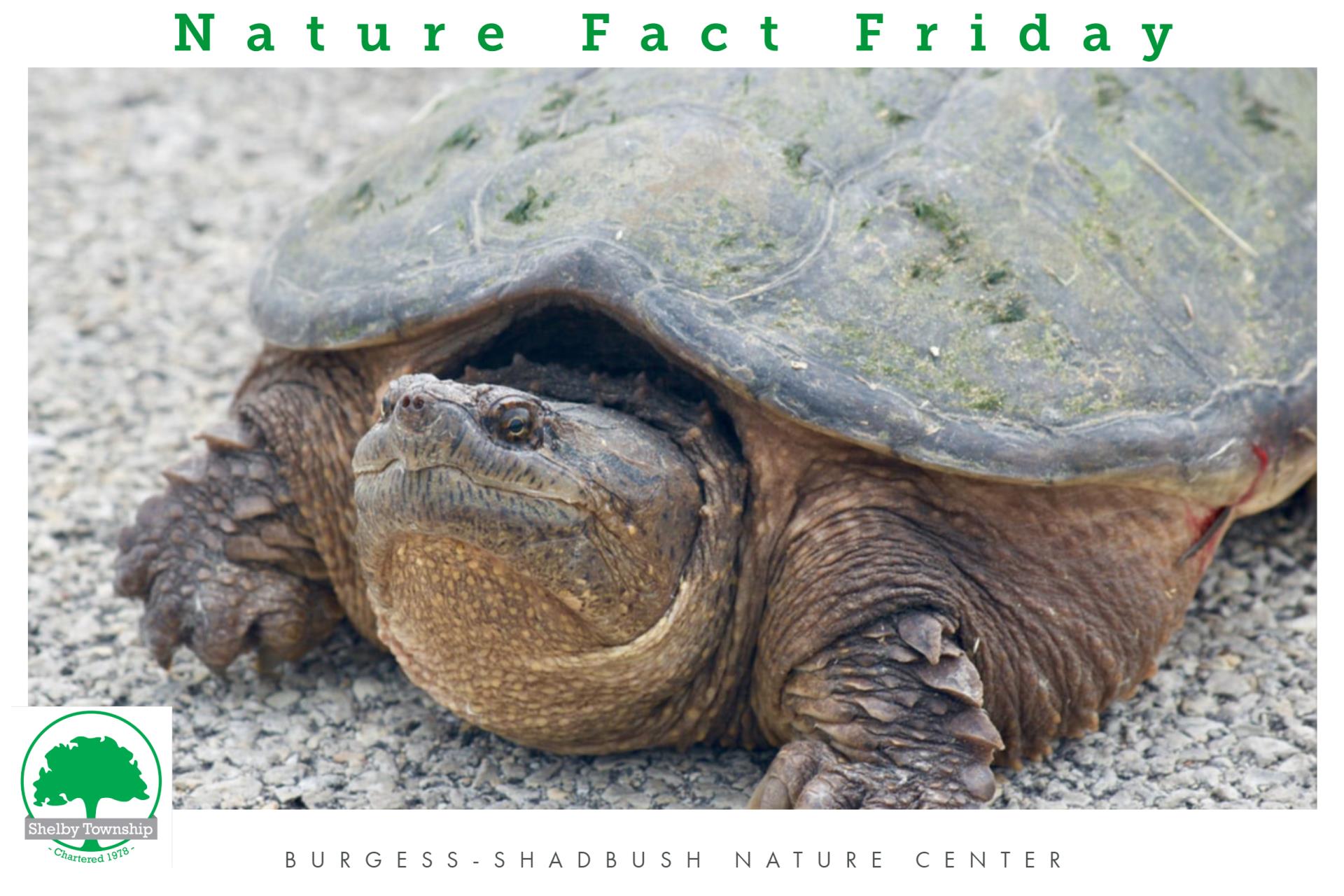 Snapping Turtle
Snapping Turtle
The common snapping turtle (Chelydra serpentina) loves freshwater and can be found in River Bends Park by the river.
Snapping turtles are aggressive out of water, especially when cornered. Their mouth is shaped like a sharp, toothless beak they use as their main defense but they also have sharp claws. They can travel miles over land searching for new freshwater and may present an obstacle on trails or roads. Picking one up can prove painful and it's best to let professionals deal with relocating them.
They eat anything they can, from dead animals to insects, fish, birds, small mammals, amphibians and aquatic plants.
Spring is that time of year when baby animals start to show up. Baby animals are resilient and rarely need humans to intervene. Their best possible chance of survival is with their mother. So what do you do if you find a baby animal? Follow the instructions below.
Remember, it is illegal to try and care for baby animals if you do not have a permit to do so. Wildlife rehabbers go through extensive schooling and training to properly care for wild animals. You can find a list of Michigan rehabbers at: https://www2.dnr.state.mi.us/dlr/.
Baby Deer
If the fawn is lying quietly, leave her be. Mom only comes by 2-3 times per day to nurse her fawn.
Do not touch the fawn and keep pets away.
If you removed the fawn, put her back where you found her immediately.
If the fawn is clearly injured, has been wandering and crying for hours, or the mom is deceased, contact a wildlife rehabilitator.
Baby Bunny
If the baby rabbit:
-is bleeding, has an open wound, or a broken bone
-been in a cat's or dog's mouth
-is covered in fly eggs (looks like small grains of rice)
-is cold, wet or crying nonstop
Take the rabbit to a wildlife rehabilitator or veterinarian.
Baby Squirrel
If it is bleeding or clearly injured, call a wildlife rehabilitator.
If unharmed, leave it be at the tree's base or in a wicker basket securely attached to the tree so Mom can retrieve them - she wants her baby back.
If it's chilly, place a chemical hand warmer under the baby - or put them in a shoebox nestled in a flannel shirt with a heating pad on low under the box.
Keep pets away! Especially cats. Watch from a distance and if mom does not retrieve the baby by nightfall, they may be orphaned - call a wildlife rehabilitator.
Baby Opossum
Opossums breed two or three times each year, from February to September, with the average litter containing six to nine babies. Opossum babies remain in their mother's pouch until they are about two months old. Between two and four months of age, they ride on their mother's back and are dependent on her for care.
Is the opossum injured? (Bleeding, broken bones, wounds, deformity, etc.)
If yes, contact your nearest wildlife veterinarian or rehabilitator.
If the opossum is unharmed, at least 8 inches long from tip of nose to the base of the tail and weigh more than 7.25 ounces or 200 grams, they are old enough to survive on their own in the wild and do not need human intervention. If the opossum doe not meet the size and weight criteria, contact a wildlife rehabilitator immediate.
Opossum babies are often found with or near their dead mothers after the mother opossum has been killed by a car. Remove the babies from the dead mother's pouch as soon as possible and keep them warm until they are taken to a permitted rehabilitator.
